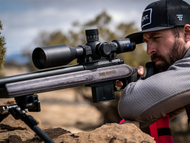First Focal Plane vs Second Focal Plane Scopes
Posted by Red Hawk Rifles on Jan 22nd 2024
One of the most common questions surrounding rifle scopes is whether or not you should use a First Focal Plane (FFP) or a Second Focal Plane (SFP) scope. Which one you use really depends on the type of shooting you plan on doing. This is because each has their own strengths and weaknesses.
So we are going to go over the difference between first and second focal plane scopes, their pros and cons, and what each style is ideally used for.
What is a Focal Plane?
Starting off we need to know what we’re talking about. A focal plane is the converging point of light when it goes through a lens but is not parallel to our optical axis. Since we’re dealing with multiple lenses in a rifle scope this doesn’t necessarily help us.
However it does give us an idea of how first and second focal planes work regarding our reticle. Since light is going to be converging within two parts of our scope, which lens we place that reticle on will determine how we perceive the reticle.
This perception will change under magnification depending on whether the reticle is on the first plane or second plane. But one thing remains constant and that is the center aiming point of the reticle. This means which focal plane you choose comes down to how you use the rest of the reticle. Let’s look at each in a little more detail.
Second Focal Plane Scopes
Second Focal Plane scopes like the Nightforce’s NX8 F2 are what people generally think of when it comes to scope performance. Since the reticle is on the second focal plane it will remain a constant size at every level of magnification that scope has.
This consistency of reticle size provides a very usable sight picture at most magnifications. The problem comes in when you are trying to use your reticle to range a target. This is because a Second Focal Plane reticle’s markings will only correspond accurately on the highest setting.
Most hunting scopes are Second Focal Plane and are not a hindrance for hunters since the consistent reticle size works well within most hunting scenarios, except for exceptionally long range hunts.
Second Focal Plane scopes lack versatility when it comes to fine tuning a scope at various magnifications but this is more of a concern for precision shooters and competitors.
Pros
- Reticle is a constant size
- Second Focal Plane Scope are more affordable
- Easy to understand
Cons
- Reticle measurements only apply on the highest setting
- Not as useful during dynamic shooting with multiple distances
- Requires dialing the scope for best results
First Focal Plane Scopes
First Focal Plane scopes place the reticle on the lens closer to the shooter and this means that as magnification is adjusted, the reticle will change size. This means that the measurements of the reticle will hold a constant value at every magnification the scope has.
This usually results in First Focal Plane reticles having integrated bullet drop compensators and hold over points. This allows you to quickly plot your holds without changing your magnification. However this also means you have to find your preferred magnification for your current situation.
Having a consistent value for your reticle makes it a great tool for range estimation in addition to it being very versatile. This makes it a preferred option for competition shooters who may have to transition between targets at multiple different ranges.
However First Focal Plane scopes do have their drawbacks. Often the reticles are extremely small at low magnification, this can be offset by using an illuminated reticle like the NX8 F1 does. But this does add more maintenance for the scope since you’ll have to keep up with battery usage.
First Focal Plane scopes are also more expensive than Second Focal Plane options. This means you should be absolutely sure a First Focal Plane is what you need for your rifle setup.
Pros
- Has constant values for reticle markings
- Usually paired with “Christmas tree” or Bullet Drop marks
- Does not need to be dialed in to use
- Good for multiple targets under time constraints
Cons
- Reticle can be too small at lower magnifications
- First Focal Plane scopes usually are more expensive
- May require illumination under low magnification
Which scope style is best for you?
Unlike many things in the firearms world, here we have a more clear cut answer when it comes to selecting the appropriate scope for you.
If you are hunting or consistently using maximum magnification for your shooting, like precision or long range shooting for example, a Second Focal Plane scope is going to be your best option. This allows you to dial in the scope, take your time, and have a consistent reticle.
If you are in a faster paced environment where you will be switching between targets a lot, a First Focal Plane scope will be the better option. This means competition or similar situations where you might have to leave your scope on an average setting and use a hold over method instead of carefully calculating your shot.
At the end of the day, personal preference, budget, and situation will determine which optic is best for your current or future rifle setup.








